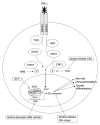Impact of alcohol on hepatitis C virus replication and interferon signaling
- PMID: 20238400
- PMCID: PMC2842525
- DOI: 10.3748/wjg.v16.i11.1337
Impact of alcohol on hepatitis C virus replication and interferon signaling
Abstract
Hepatitis C virus (HCV) is one of the main etiological factors responsible for liver disease worldwide. It has been estimated that there are over 170 million people infected with HCV worldwide. Of these infected individuals, approximately 75% will go on to develop a life long necroinflammatory liver disease, which over decades, can result in serious complications, such as cirrhosis and hepatocellular carcinoma. Currently there is no effective vaccine and whilst antiviral therapies have been improved, they are still only effective in approximately 50% of individuals. HCV infection stands as a major cause of global morbidity and suffering, and places a significant burden on health systems. The second highest cause of liver disease in the western world is alcoholic liver disease. Frequently, HCV infected individuals consume alcohol, and the combined effect of HCV and alcohol consumption is deleterious for both liver disease and response to treatment. This review discusses the impact of alcohol metabolism on HCV replication and the negative impact on interferon (IFN)-alpha treatment, with a particular focus on how alcohol and HCV act synergistically to increase oxidative stress, ultimately leading to exacerbated liver disease and a reduction in the efficacy of IFN-alpha treatment. A better understanding of the complicated mechanisms at play in hepatocytes infected with HCV and metabolizing alcohol will hopefully provide better treatment options for chronic hepatitis C individuals that consume alcohol.
2010 Baishideng. All rights reserved.
Figures


Similar articles
-
Hepatitis C, innate immunity and alcohol: friends or foes?Biomolecules. 2015 Feb 5;5(1):76-94. doi: 10.3390/biom5010076. Biomolecules. 2015. PMID: 25664450 Free PMC article. Review.
-
Hepatitis C virus replication in mouse cells is restricted by IFN-dependent and -independent mechanisms.Gastroenterology. 2013 Dec;145(6):1414-23.e1. doi: 10.1053/j.gastro.2013.08.037. Epub 2013 Aug 21. Gastroenterology. 2013. PMID: 23973921
-
Alcohol impairs interferon signaling and enhances full cycle hepatitis C virus JFH-1 infection of human hepatocytes.Drug Alcohol Depend. 2010 Nov 1;112(1-2):107-16. doi: 10.1016/j.drugalcdep.2010.05.008. Epub 2010 Jun 20. Drug Alcohol Depend. 2010. PMID: 20646875 Free PMC article.
-
Alcohol metabolism increases the replication of hepatitis C virus and attenuates the antiviral action of interferon.J Infect Dis. 2008 Dec 15;198(12):1766-75. doi: 10.1086/593216. J Infect Dis. 2008. PMID: 18956976
-
Mechanisms of synergy between alcohol and hepatitis C virus.J Clin Gastroenterol. 2007 Sep;41(8):761-72. doi: 10.1097/MCG.0b013e3180381584. J Clin Gastroenterol. 2007. PMID: 17700425 Review.
Cited by
-
Current status and future directions in the management of chronic hepatitis C.Virol J. 2012 Mar 2;9:57. doi: 10.1186/1743-422X-9-57. Virol J. 2012. PMID: 22385500 Free PMC article. Review.
-
Alcohol consumption effect on antiretroviral therapy and HIV-1 pathogenesis: role of cytochrome P450 isozymes.Expert Opin Drug Metab Toxicol. 2012 Nov;8(11):1363-75. doi: 10.1517/17425255.2012.714366. Epub 2012 Aug 8. Expert Opin Drug Metab Toxicol. 2012. PMID: 22871069 Free PMC article. Review.
-
Interplay between Hepatitis C Virus and Redox Cell Signaling.Int J Mol Sci. 2013 Feb 26;14(3):4705-21. doi: 10.3390/ijms14034705. Int J Mol Sci. 2013. PMID: 23443167 Free PMC article.
-
Predictors of alcohol use among rural drug users after disclosure of hepatitis C virus status.J Stud Alcohol Drugs. 2013 May;74(3):386-95. doi: 10.15288/jsad.2013.74.386. J Stud Alcohol Drugs. 2013. PMID: 23490567 Free PMC article.
-
Unreported alcohol use was common but did not impact hepatitis C cure in HIV-infected persons who use drugs.J Viral Hepat. 2020 May;27(5):476-483. doi: 10.1111/jvh.13251. Epub 2020 Jan 7. J Viral Hepat. 2020. PMID: 31854069 Free PMC article. Clinical Trial.
References
-
- Dore GJ, Law M, MacDonald M, Kaldor JM. Epidemiology of hepatitis C virus infection in Australia. J Clin Virol. 2003;26:171–184. - PubMed
-
- Thomas DL, Astemborski J, Rai RM, Anania FA, Schaeffer M, Galai N, Nolt K, Nelson KE, Strathdee SA, Johnson L, et al. The natural history of hepatitis C virus infection: host, viral, and environmental factors. JAMA. 2000;284:450–456. - PubMed
-
- Poynard T, Bedossa P, Opolon P. Natural history of liver fibrosis progression in patients with chronic hepatitis C. The OBSVIRC, METAVIR, CLINIVIR, and DOSVIRC groups. Lancet. 1997;349:825–832. - PubMed
-
- Seeff LB, Buskell-Bales Z, Wright EC, Durako SJ, Alter HJ, Iber FL, Hollinger FB, Gitnick G, Knodell RG, Perrillo RP. Long-term mortality after transfusion-associated non-A, non-B hepatitis. The National Heart, Lung, and Blood Institute Study Group. N Engl J Med. 1992;327:1906–1911. - PubMed
Publication types
MeSH terms
Substances
LinkOut - more resources
Full Text Sources

